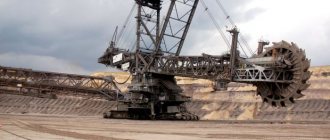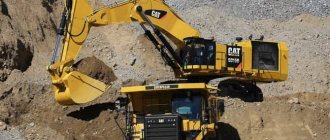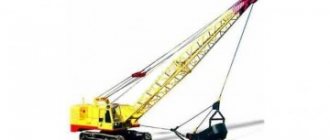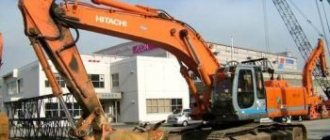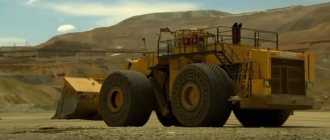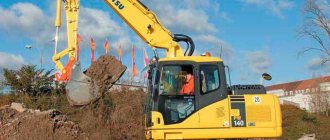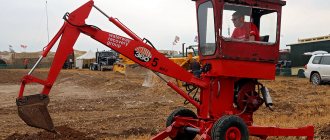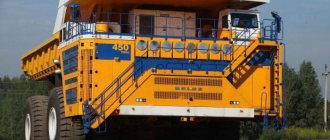Excavator is a common name around the world for earth-moving machines that are equipped with a bucket. There are several dozen modifications of these mechanized devices.
They differ from each other in the method of operation (universal construction, mine, trench, single-bucket), in the type of undercarriage used (walking, tracked, wheeled, etc.), in purpose, in design and, of course, in size.
An example of a wheeled excavator is EO 2621.
Excavators are used in construction (including road construction), in quarries, and in mine workings . A feature of this type of earthmoving machines is that the bucket (working body) moves independently of the chassis.
In addition to excavators, dump trucks also work in quarries, for example, the largest mining dump truck - BelAZ 75710.
Leonardo da Vinci is considered to be the inventor of the excavator, who created a general drawing and schematic diagram of a machine similar to a modern dragline excavator. The first working excavator was developed by Smith Otis, an American mechanic, in the mid-30s of the nineteenth century.
An example of a modern backhoe loader is the JBC 3CX.
Hitachi EX8000-6
Hitachi EX8000-6 - a modern hydraulic excavator from Hitachi opens the rating of large excavators. The machine was built in 2012 for coal mining. Compared to other representatives of the rating, it cannot boast of very impressive dimensions, but despite this, it has good characteristics. The mechanism is capable of lifting up to 75 tons at a time, and its power is 3880 horsepower. The Hitachi EX8000-6 is about 10 meters high and over 30 meters long. The bucket volume of this model is 40 cubic meters.
Chernyshevskaya station, St. Petersburg (131 m)
Leningrad is famous for its “best-best” traditions. Not only did Peter I bother to build a fortress and a shipyard in uninhabited, swampy places. So the place turned out to be really strategic! And the city of Peter the Great, gradually growing, felt the need to build a metro.
The trouble is that swampy and very “floating” soils force tunnels to be built at considerable depth. It is not surprising that in our ranking of the “best escalators,” the City of Petra takes three honorary prizes.
The name of Chernyshevskaya station can be misleading. Its exit to the surface is, indeed, located near Chernyshevsky Avenue. However, the name of the station is exactly that: “Chernyshevskaya”, which is reflected on the pediment. The escalators at this station are 131 meters long.
Interesting fact: it was at this station that indirect lighting (with disguised lamps) was used for the first time in the history of Soviet metro construction.
Marion 6360
The Marion 6360 is one of the ten largest excavators in the world. Its creator is the American company Marion Power Shovel, built in 1965. Merion's weight was about 13 thousand tons, and the length of her boom exceeded 67 meters. Eskazavr has been in business for over three decades. It fell into disrepair after a malfunction occurred in the mechanism in 1991, which led to spontaneous combustion of the car. Restoring the structure was considered impractical, so after this accident the legendary Marion 6360 was abandoned.
Umeda, Osaka (173 m)
Why are we all about the subway, but about the subway? In Japan, in the city of Oskaka , you can find such a wonderful miracle as an escalator that slowly takes the visitor to a height of 173 meters!
The miracle stairs are located inside two towers of the Umeda Sky Building commercial complex, built in 1993.
In fact, the length of the escalators significantly exceeds the designated 173 meters, since they lead from level to level on the way to the top - the famous “airy garden”.
But the owner of the building, in response to the question about the total length of the mechanical stairs, only squints his eyes sarcastically (purely in Japanese).
Big Muskie
Big Muskie is the world's largest spider excavator, created in the second half of the last century by the American company Bucyrus-Erie. The total mass of the colossus is about 13 thousand tons. Big Muskie is almost 68 meters high, more than 46 meters wide and about 150 meters long. The bucket volume is 168 cubic meters, which can accommodate two buses. The company took two full years to build at a final cost of $25 million. Big Musk needed enough electricity to power about 30,000 apartments. The machine has been in operation for 30 years. During this time, the dragline produced 20 million tons of coal.
RH 400
The RH 400 is the largest hydraulic excavator in the world, built by the German company O&K. The weight of the mechanism is about 100 tons, and its power is 3.3 megawatts. The bucket of this model holds about 50 cubic meters. The RH 400 is ready for work even in very adverse weather conditions thanks to its advanced oil heating system. The engine power is 4,500 horsepower, and the fuel tank of the unit is designed for 15 thousand liters of fuel. The cost of one of these copies will cost the buyer 14 million dollars.
Caterpillar 8750 Dragline
7,500 tons
As you know, Caterpillar is the world's largest manufacturer of construction equipment. And, of course, in terms of building large earth-moving machines, it did not stand aside.
The Caterpillar 8750 Dragline is a heavy-duty dragline excavator designed for working in deep quarries. Its characteristics: weight - 7500 tons, bucket - 129 cubic meters (lifts up to 345 tons), boom length - 132 meters. This machine can work on any type of surface, in any weather conditions, as well as at temperatures from -40 to +40 degrees.
This excavator can be equipped with two different types of electric motors - DC and AC. The first type of engine is more unpretentious, and the second is more economical. The Caterpillar 8750 Dragline has proven itself to be a reliable and maintainable excavator, which is why it is popular on mining sites throughout the United States and Canada.
Bagger 293
Bagger 293 is one of the largest mining excavators in the world, listed in the Guinness Book of Records. The weight of the mechanism is 14 tons, the height is equal to a thirty-story building, and the length exceeds two hundred meters. The Bagger 293 was built specifically for quarrying. A team of five people is working to check the machine. The device moves at a speed of just over 6 km per hour. This machine is capable of moving about 3 million cubic meters every day. In a day's work, the Bagger 293 can dig a hole the size of a football field. On board the special vehicle there are lifting mechanisms and workshops for its repair.
INTERESTING TOP 10 Phones similar to iPhone X
R&N4100HRS
R and N4100XRS is the largest Russian mining excavator. The giant machine weighs more than 1.5 tons, and the bucket volume is 57 cubic meters. The P&H4100XRS can process 200 million tonnes of rock per year, of which six huge BelAZ trucks weighing 320 tonnes are used for export. The owner of the installation is . With the help of an excavator, the company manages to extract up to 15 million tons of coal per year. & N4100ХРС completely justifies the money that had to be paid for it: its purchase cost the company 575 million rubles. This design can replace four conventional excavators. The machine is driven by two excavators, which also have a rest area and a toilet in the cabin.
Leveling and automated control systems
Improving controllability and precision while reducing energy consumption are goals that leading manufacturers of modern heavy excavators strive for. Of course, the old method of excavation is inconvenient - the operator must often stop the work to check whether the leveling has been carried out correctly, and if an error is found, redo the work. Systems that automate the management of work processes and help operators and machine fleet managers do their jobs significantly increase the productivity and economic efficiency of machine operation. Managers can effectively monitor the progress of work and equipment loading using telematic equipment navigation systems.
The heaviest in the line of Caterpillar for oil and gas and construction purposes are the mod. 390FL and 374FL weighing 92 and 75 tons, respectively, which underwent modernization in 2022. The machines are equipped with a variety of automated systems, ranging from simple ones, such as SmartBoom, which automates the control of the same repetitive boom movements, and PAYLOAD Technologies, an automatic on-board load weighing system that informs the operator in real time, to more complex ones, such as Cat Grade with Assist leveling systems – two-dimensional 2D and three-dimensional 3D. The system provides automatic execution of movements that were previously controlled manually by the operator. The system is especially useful during the final stages of work: it indicates when to stop excavating, thus preventing unnecessary work and the cost of correcting errors. The operator just needs to enter the digging depth and slope angle, and the system will show him on the color monitor screen how to cut or fill the soil, eliminating the need to involve surveyors to mark work sites with pegs and check surface angles. The system warns with an audible signal when the machine needs to be stopped.
But the list of automated systems for Caterpillar excavators does not end there. Telematics systems Cat VisionLink, Cat Connect, Cat ProductLink allow you to remotely collect a lot of data about the operation of company machines, track the location and movements of machines, monitor fuel consumption, determine which operators need additional training, create reports on the operation of equipment and a machine maintenance schedule, control its implementation, increase the useful time and serviceability of excavators, etc., in general, help save working time and finances of the company.
The Hitachi ZX870 LC-6 and ZX670LC-6 excavators are equipped with the ZXLink Ultimate telematics system, which registers and presents to the operator and fleet managers many machine operating parameters: its location, travel routes, fuel consumption, number of engine hours worked; performing fault diagnosis, reporting, etc.
In the future, automation of control over the operation of road construction equipment will increase, experts say. The next step in increasing efficiency and productivity will be the creation of systems that coordinate the operation of all machine units employed at a construction site.
Bucyrus RH400
The Bucyrus RH400, also known as the Big Brutus, is one of the most gigantic excavators in the world, developed by Bucyrus-Erie. The machine was used for open-pit coal mining. Big Brutus was able to extract stones from a depth of more than 20 meters. The Bucyrus RH400's maximum annual production (when operating at full capacity) can be 260 hectares. During this cycle, the monster was able to instantly fill 3 huge carriages. The weight of the car is about 900 tons, and the engine power is 4400 horsepower. The Big Brutus tracks are over ten meters long. This one-of-a-kind specimen is currently housed in the American Western Mineral Museum.
Station Park Pobedy, Moscow (130 m)
The next four champions are located in Russia. For example, the Moscow metro station Park Pobedy has escalator tracks 130 meters long.
The need for escalators of such a significant length is associated with the rather large depth of the station. Official sources report that the basic o.
Interesting fact: Victory Park station is officially considered the deepest station of the Moscow metro.
Bagger 288
The Bagger 288 completes the list of the largest excavators in the world. It was built by Krupp in 1978. The customer for the machine was the mining company Rheinbraun, which required a machine capable of working at very great depths. In the end, the cost of the car was paid to the company in the amount of US$100 million. The excavator extracts such a quantity of rocks per day that about 4,000 KAMAZ trucks will be required to transport them. The Bagger 288 is equipped with 18 buckets, each with a volume of approximately 7 cubic meters and a height of approximately 2 meters. It can process about 10,000 cubic meters of mined rock every hour. The giant's height is almost 100 meters and its length is more than 200 meters. The weight of the monoblock structure is more than 13 thousand tons. In parallel, a team of four people is working on Bagger 288. The speed of movement of the colossus is only half a kilometer per hour.
INTERESTING The coldest winters in Russia in 100 years
The largest excavator in Russia
Large quarry equipment is also assembled in Russia. Among them are the latest rotary machines for open-pit mining.
ERSHRD-5250
Rotary walking-rail mining excavator - this is how the brand stands for. In the context of the town of Sharypovo “Berezovsky-1” there are 2 units of equipment working at once. The maximum cutting height is 60 meters, the height of the boom allows mining from 30 meters, so they work in pairs.
The rotor wheel rotates without stopping, coal fills the buckets
There are 20 buckets attached to the rotary wheel; 5250 m3 of rock is mined per hour. The rotor rotates continuously, scooping up coal. ERSHRD-5250 operates using two electric drives.
This is what the buckets of the ERSHRD-52501 rotary excavator look like

